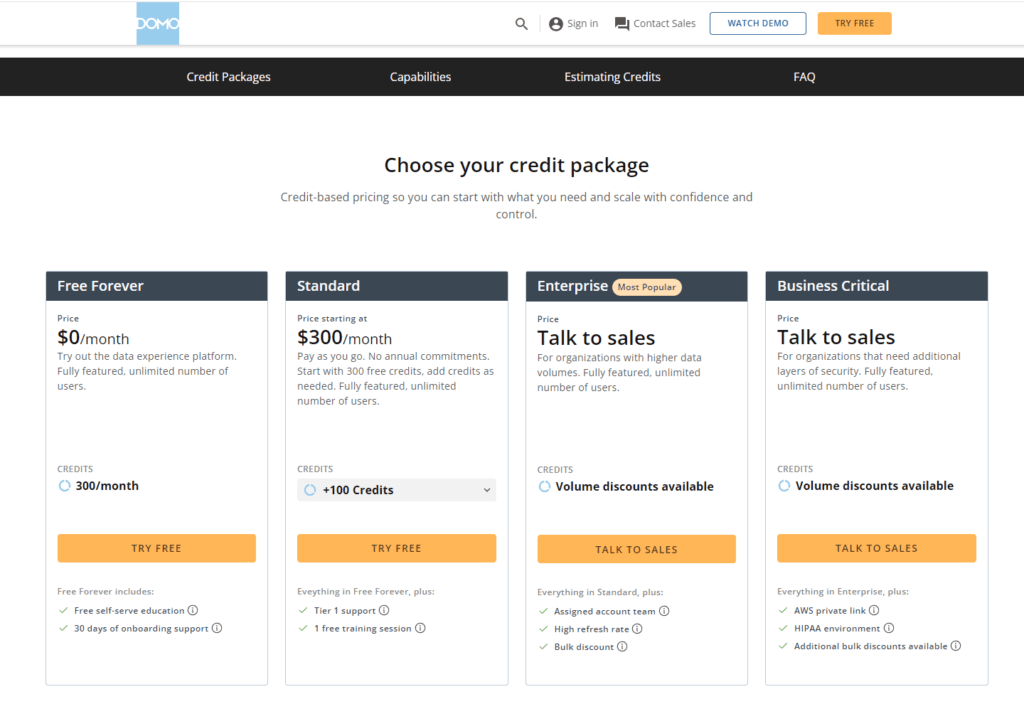Choosing the right analytics tool is like selecting the perfect pair of glasses. Pick the right one, and you see the world with crystal clarity. Pick the wrong one, and you’re left squinting, missing out on the finer details of your surroundings. In the vast landscape of analytics tools, Clicky and Domo stand out as two options worth considering. Each offers unique features designed to bring the online performance of your website or business into focus. But which one is the right fit for you?
Clicky | Domo |
|---|---|
| G2 Score – 4.5 out of 5 stars | G2 Score – 4.4 out of 5 stars |
| TrustRadius Score – 5/10 | TrustRadius Score – 8.5/10 |
Real-Time Analytics: The Pulse of Your Online Presence
In the fast-paced digital world, having your finger on the pulse of your website or business’s online activity is crucial. Real-time analytics allow you to monitor visitor behavior, traffic sources, and engagement metrics as they happen, enabling you to make immediate decisions and adjustments. Here’s how Clicky and Domo measure up in providing real-time insights.
Clicky: The Real-Time Radar
Clicky is like a radar constantly scanning the skies, offering a detailed, moment-by-moment view of what’s happening on your website. Its real-time analytics dashboard is designed for immediacy and depth, providing insights into who is on your site right now, what pages they’re viewing, where they came from, and a plethora of other live data points.
This immediacy is Clicky’s forte. You can watch as visitors move through your site, identifying patterns, bottlenecks, and opportunities as they occur. For businesses and website owners who thrive on instant data to make quick decisions—whether it’s pushing a timely marketing message or troubleshooting a sudden drop in traffic—Clicky’s real-time analytics are invaluable.
Domo: The Strategic Observer
Domo approaches real-time analytics from a broader, more strategic angle. While it offers live data capabilities, its strength lies in integrating real-time insights into a larger data ecosystem. Domo is designed to aggregate data from multiple sources—social media, CRM, ERP, and more—providing a holistic view of your business’s performance across all channels.
Domo’s real-time analytics are part of a suite of business intelligence tools, allowing for deeper analysis and strategic planning. This platform is suited for larger organizations or those with complex data needs that span beyond website analytics, offering real-time insights as part of a comprehensive business overview.
Customization and Dashboard Usability
The ability to tailor an analytics platform to your specific needs and preferences is akin to charting your own course through uncharted waters. A customizable dashboard not only ensures that the most relevant data is always at your fingertips but also enhances your ability to make informed decisions quickly. Let’s see how Clicky and Domo stack up in providing a personalized analytics experience.
Clicky: The Flexible Navigator
Clicky is akin to a nimble vessel, offering significant flexibility in how you set up and view your analytics dashboard. The platform allows you to customize which data you see first, enabling you to prioritize the metrics that matter most to you. Whether you’re focused on tracking real-time visitor behavior, monitoring specific goals, or analyzing site-wide trends, Clicky’s dashboard can be adjusted to meet your unique needs.
One of Clicky’s standout features is its simplicity in customization. You don’t need to be a seasoned sailor of digital analytics to arrange your dashboard. With just a few clicks, you can add, remove, or rearrange widgets to create a view that provides immediate insight into your website’s performance. This ease of use makes Clicky particularly appealing to small and medium-sized businesses or individual website owners looking for a straightforward, effective analytics tool.
Domo: The Master Cartographer
Domo, on the other hand, is like a fully equipped exploration ship, designed for navigating complex data landscapes. Its dashboard customization capabilities are extensive, supporting a wide range of data visualizations, including charts, graphs, and custom reports. Domo caters to organizations with diverse data sources, offering the ability to integrate and visualize data from over a thousand different connectors.
Domo’s strength lies in its depth and flexibility, allowing users to create highly personalized dashboards that can encompass not just website analytics but all aspects of business intelligence. This comprehensive approach ensures that decision-makers have a 360-degree view of their business’s performance, all in one place. However, navigating Domo’s extensive customization options may require a more experienced hand, making it better suited for larger organizations with dedicated data analysis teams.

Related: Check out our free SEO suite

Integration Capabilities
In today’s digital world, your analytics tool isn’t just a standalone island; it’s part of a larger archipelago of business and marketing tools. The ability of your analytics platform to integrate seamlessly with other applications and services can significantly enhance its utility, making this a critical area of comparison. Let’s see how Clicky and Domo fare in their ability to connect with other digital territories.
Clicky: The Agile Connector
Clicky, akin to a swift sloop, offers a focused set of integrations designed to enhance its core analytics functionality. While it may not boast the extensive integration ecosystem of larger platforms, Clicky covers the essentials well. It integrates with popular content management systems, ecommerce platforms, and digital marketing tools, ensuring that small to medium-sized businesses can connect their website analytics with other key operational tools.
One of the advantages of Clicky’s integration approach is its simplicity. The platform makes it easy to link your site with services like WordPress, Shopify, or Google Search Console, providing a streamlined setup process that doesn’t require a seasoned navigator of digital tools. This makes Clicky an attractive option for website owners who need to integrate their analytics with a handful of other services without the complexity often associated with more extensive ecosystems.
Domo: The Comprehensive Platform
Domo, resembling a mighty galleon, boasts a vast and varied integration ecosystem. With support for over a thousand connectors, Domo is designed to be the central hub of your business’s digital data landscape. Whether it’s sales data from CRM platforms, marketing metrics from social media, financial insights from ERP systems, or any other data source, Domo can bring it all together into a cohesive, comprehensive view.
The strength of Domo’s integration capabilities lies in its ability to not just connect with other tools but to blend and analyze data from disparate sources, offering deep insights that span across the entirety of a business’s operations. This level of integration is particularly valuable for large organizations or those with complex data needs, as it allows for nuanced analysis and strategic decision-making based on a holistic understanding of business performance.
Support and Community
In the vast sea of digital analytics, even the most experienced navigator may encounter storms or seek guidance on the best course forward. The level of support provided by an analytics platform and the strength of its user community can be a lifeline in these situations, ensuring you’re never adrift. Let’s examine how Clicky and Domo support their users and foster communities around their tools.
Clicky: The Responsive Crew
Clicky, much like a nimble vessel with a dedicated crew, offers direct and efficient support to its users. The platform provides a comprehensive help section, including a detailed FAQ and a knowledge base that covers a wide range of topics, from setup and configuration to advanced feature use. For more personalized assistance, Clicky offers support via email, where users can expect timely and helpful responses to their inquiries.
Beyond the official channels, Clicky benefits from a loyal user base, with various online forums and communities where users share tips, tricks, and advice. While the Clicky community may not be as large as those of some other platforms, it is characterized by its engagement and willingness to help fellow users navigate the analytics waters.
Domo: The Vast Fleet
Domo, on the other hand, commands a vast fleet, with support and community resources as expansive as its integration capabilities. Domo offers a range of support options, including a robust online knowledge base, training resources, and direct support through email, phone, and a ticketing system for more complex issues. Domo University, an online learning platform, provides users with in-depth training modules to help them maximize the platform’s capabilities.
The Domo community is a significant asset, comprising a wide network of users, developers, and data experts. The Domo online forum serves as a bustling marketplace of ideas, where users can ask questions, exchange insights, and learn best practices from peers and Domo experts alike. Additionally, Domo-sponsored events and user groups offer opportunities for networking and learning, further strengthening the community.
Reporting and Data Visualization capabilities
In the realm of digital analytics, the power to transform raw data into insightful, actionable information is akin to discovering a map that reveals pathways to treasure. Both Clicky and Domo offer tools to chart the course of your website and business performance, but they do so with different approaches and strengths. Let’s navigate through their reporting and data visualization features to see which platform might best illuminate your path to data-driven decisions.
Clicky: The Streamlined Chartmaker
Clicky, much like a skilled cartographer, provides clear and concise reporting that allows users to quickly grasp their website’s performance. The platform’s reports are straightforward, offering a no-frills approach to data visualization that makes it easy to understand at a glance. Clicky’s strength lies in its ability to present key metrics in a digestible format, ideal for those who need to monitor their website’s health and make quick adjustments.
The platform includes a variety of standard reports, such as traffic sources, visitor behavior, and detailed breakdowns of individual sessions. Clicky’s dashboards can be customized to highlight the most relevant reports for your needs, ensuring that the most critical data is always front and center. While Clicky may not offer the depth of customization and breadth of visualization options as some more comprehensive platforms, its simplicity and clarity are its hallmarks, making it an excellent choice for users who prioritize ease of use and immediate insights.
Domo: The Master of Data Artistry
Domo, on the other hand, is a master of data artistry, offering expansive reporting and data visualization capabilities that cater to the most intricate business intelligence needs. The platform allows users to create highly customized dashboards that can incorporate a wide array of data sources, presenting a unified view of business performance across all functions.
Domo’s data visualization tools are among the most advanced on the market, enabling users to craft detailed charts, graphs, and maps that can illuminate patterns and trends in the data that might otherwise remain hidden. With an emphasis on customization, Domo allows users to tailor every aspect of their reports, from the data sources and metrics included to the aesthetics of the visualizations. This level of detail and flexibility makes Domo an ideal choice for larger organizations or those with complex data analytics requirements that go beyond website performance to encompass broader business metrics.
Pricing
Clicky:

Domo:

Conclusion
In navigating the vast seas of digital analytics, our journey comparing Clicky and Domo has illuminated each platform’s unique capabilities and strengths. Clicky, with its straightforward, user-friendly approach, offers real-time insights and streamlined reporting ideal for website owners seeking simplicity and immediate data interpretation. Its focus on ease of use and clarity makes it a valuable compass for small to medium-sized businesses aiming to understand and react to their online presence swiftly.
Domo, on the other hand, charts a course through more complex waters, providing expansive integration capabilities, comprehensive support resources, and advanced reporting and data visualization tools. It stands as a formidable vessel for larger organizations or those with intricate data landscapes, requiring a panoramic view of their business performance across multiple channels and platforms.
Read Next:
- MeetEdgar vs. Kontentino: The Best Social Media Management Tool for You
- Amplitude vs Looker: The Best Marketing Analytics Tool for You
- Adobe Analytics vs Heap: The Best Marketing Analytics Tool for You
- MeetEdgar vs SmarterQueue: The Best Social Media Management Tool for You
- Monday.com vs Wrike: The Best Project Management Tool for You





















Comments are closed.